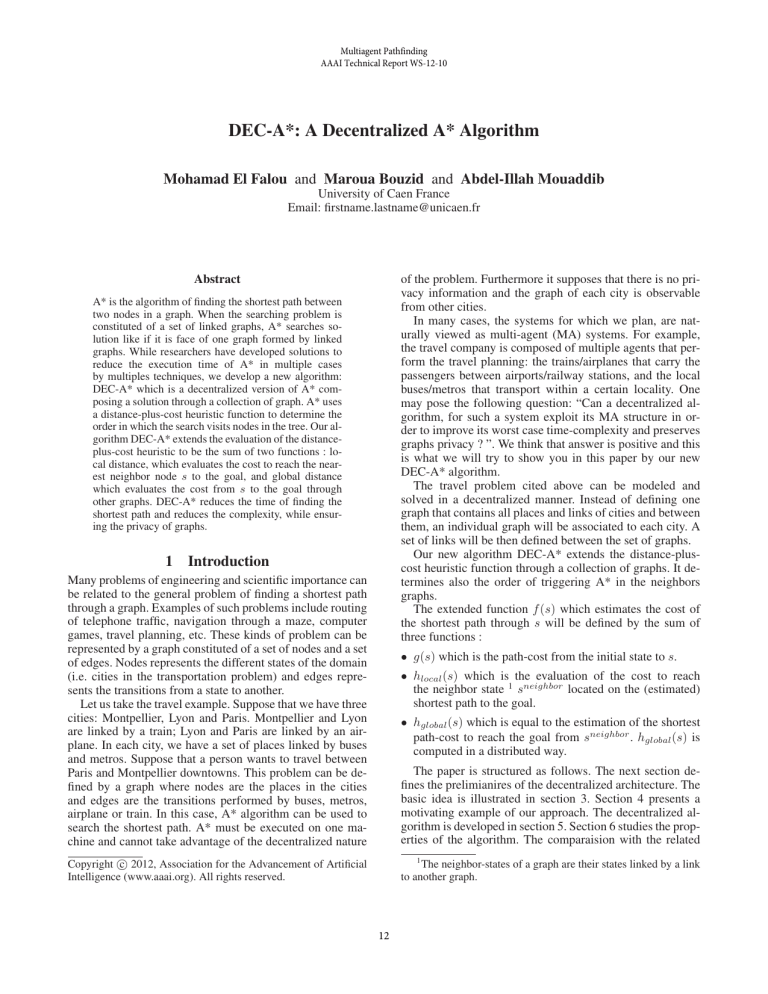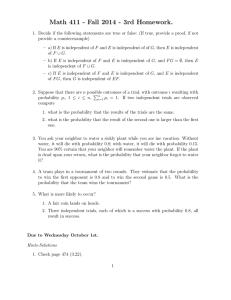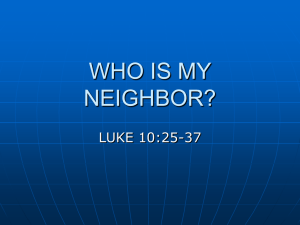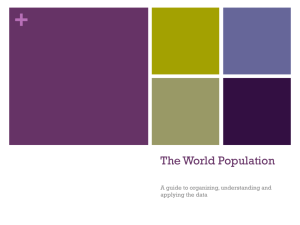
Multiagent Pathfinding
AAAI Technical Report WS-12-10
DEC-A*: A Decentralized A* Algorithm
Mohamad El Falou and Maroua Bouzid and Abdel-Illah Mouaddib
University of Caen France
Email: firstname.lastname@unicaen.fr
Abstract
of the problem. Furthermore it supposes that there is no privacy information and the graph of each city is observable
from other cities.
In many cases, the systems for which we plan, are naturally viewed as multi-agent (MA) systems. For example,
the travel company is composed of multiple agents that perform the travel planning: the trains/airplanes that carry the
passengers between airports/railway stations, and the local
buses/metros that transport within a certain locality. One
may pose the following question: “Can a decentralized algorithm, for such a system exploit its MA structure in order to improve its worst case time-complexity and preserves
graphs privacy ? ”. We think that answer is positive and this
is what we will try to show you in this paper by our new
DEC-A* algorithm.
The travel problem cited above can be modeled and
solved in a decentralized manner. Instead of defining one
graph that contains all places and links of cities and between
them, an individual graph will be associated to each city. A
set of links will be then defined between the set of graphs.
Our new algorithm DEC-A* extends the distance-pluscost heuristic function through a collection of graphs. It determines also the order of triggering A* in the neighbors
graphs.
The extended function f (s) which estimates the cost of
the shortest path through s will be defined by the sum of
three functions :
A* is the algorithm of finding the shortest path between
two nodes in a graph. When the searching problem is
constituted of a set of linked graphs, A* searches solution like if it is face of one graph formed by linked
graphs. While researchers have developed solutions to
reduce the execution time of A* in multiple cases
by multiples techniques, we develop a new algorithm:
DEC-A* which is a decentralized version of A* composing a solution through a collection of graph. A* uses
a distance-plus-cost heuristic function to determine the
order in which the search visits nodes in the tree. Our algorithm DEC-A* extends the evaluation of the distanceplus-cost heuristic to be the sum of two functions : local distance, which evaluates the cost to reach the nearest neighbor node s to the goal, and global distance
which evaluates the cost from s to the goal through
other graphs. DEC-A* reduces the time of finding the
shortest path and reduces the complexity, while ensuring the privacy of graphs.
1
Introduction
Many problems of engineering and scientific importance can
be related to the general problem of finding a shortest path
through a graph. Examples of such problems include routing
of telephone traffic, navigation through a maze, computer
games, travel planning, etc. These kinds of problem can be
represented by a graph constituted of a set of nodes and a set
of edges. Nodes represents the different states of the domain
(i.e. cities in the transportation problem) and edges represents the transitions from a state to another.
Let us take the travel example. Suppose that we have three
cities: Montpellier, Lyon and Paris. Montpellier and Lyon
are linked by a train; Lyon and Paris are linked by an airplane. In each city, we have a set of places linked by buses
and metros. Suppose that a person wants to travel between
Paris and Montpellier downtowns. This problem can be defined by a graph where nodes are the places in the cities
and edges are the transitions performed by buses, metros,
airplane or train. In this case, A* algorithm can be used to
search the shortest path. A* must be executed on one machine and cannot take advantage of the decentralized nature
• g(s) which is the path-cost from the initial state to s.
• hlocal (s) which is the evaluation of the cost to reach
the neighbor state 1 sneighbor located on the (estimated)
shortest path to the goal.
• hglobal (s) which is equal to the estimation of the shortest
path-cost to reach the goal from sneighbor . hglobal (s) is
computed in a distributed way.
The paper is structured as follows. The next section defines the prelimianires of the decentralized architecture. The
basic idea is illustrated in section 3. Section 4 presents a
motivating example of our approach. The decentralized algorithm is developed in section 5. Section 6 studies the properties of the algorithm. The comparaision with the related
1
The neighbor-states of a graph are their states linked by a link
to another graph.
Copyright c 2012, Association for the Advancement of Artificial
Intelligence (www.aaai.org). All rights reserved.
12
works is presented in section 7. The paper is concluded in
section 8 by summarizing the contribution and presenting
for future work.
2
Prelimianires
The search domain D is defined by a set of graphs
< G1 , ..., Gn > and a set of links between graphs <
lij , ..., lkl >. Each graph Gi is defined by a finite set of states
Si and a finite set of transitions T ransitionsi that can be executed in a state s ∈ Si . ci (s, tr) denotes the transition cost
of executing transition tr ∈ T ransitionsi in state s ∈ Si ,
and succi (s, tr) denotes the resulting successor state. Each
link lij = si → sj has two states si , sj included in distinct graphs Gi , Gj ; i 6= j. c(lij) denotes the cost of the link
lij, neighbor(Gi ) denotes all the graphs linked with Gi and
i
Sneighbor
denotes the set of neighbor states of the graph Gi .
The problem is defined by finding the shortest path between the state init which denotes the start state, and the
state goal which denotes the end state. init, goal ∈ {S1 ∪
... ∪ Sn }.
In a graph Gi , we refer to an transition sequence as local
path πi . In the domain D, the solution of the searching problem is a global path Π defined by a sequence of local path
< π1 , π2 , ..., πn > linked by links < l1,2 , ..., ln−1,n >.
3
Figure 1: Example
The agent can change its current cell to one of the four
neighboring cells by executing one of the four possible transitions ↑→↓←. Depending on its position and the number
of blocked cells, each agent has maximum 12 links to move
from one grid to another (a, b, g, i for the agent A3,2 ). When
the agent crosses a red line, it means that it executes a link
transition. The transition cost for moving from an unblocked
cell to an unblocked cell is one. The agents must find the
shortest path from the start state a ∈ A2,1 (blue star)to the
goal state h ∈ A4,3 (red star). We use the Manhattan distances as user-supplied consistent heuristic.
Basic Idea
A distributed search algorithm consists in starting with
searching a graph called Ginit containing initial state init
to a graph called Ggoal containing goal state goal.
Our distributed algorithm is modeled as follows :
An agent Ai is associated to each graph Gi . A central
agent Ac plays the role of an interface between users and
agents. Ainit (resp. Agoal ) denotes the agent containing the
initial (resp. goal) state.
When a problem is submitted, each agent Ai computes its
global heuristic which estimates the cost of its shortest path
to the goal through its neighbor agents.
Then, the agent Ainit containing init develops A* locally
by minimizing f (s) described above until reaching sgoal
(if sgoal ∈ Ginit ) or until all neighbor states sneighbor of
S neighbor are reached.
Each reached neighbor state si activates at the other side
a new A* execution on sj as new intial state and g(sj ) is
initialized by the cost to reach it from init.
The last step cited above is repeated until reaching sgoal .
4
5
Our Approach
In this section, we propose two decentralized strategies of
DEC-A*. The fist one is based on the global and local
heurisitcs as explained in the introduction. The basic idea
behind the second strategy is to reduce the time execution
of DEC-A*, by computing off-line the lowest cost path between each couple of neighbor states of each agent.
First strategy
Global distributed heuristic
The global distributed heuristic hg is computed per agent
Ai . Let Π =< π1 , l1,2 , π2 , ..., ln−1,n , πn > the shortest path
from init to goal. Then, hg estimates the cost of the subpath < πi , li,i+1 , ..., ln−1,n , πn >.
Algorithm 1 explains the general steps to compute the
global heuristic. Firstly, each agent computes the cost of
crossing it to reach the goal (i.e. cost(πi ) line 2 of Algorithm
1) by calling Algorithm 2. Then, all the global heuristic are
initialized by +∞ (lines 3-5 in Algorithm 2) and the Algorithm 3 is called (line 7 in 1) to compute the global heuristic
hg of each agent (it starts recursively from Agoal ).
Algorithm 2 computes first the distance between each
neighbor state (line 4 in Algorithm 2) and the init (line 5
in Algorithm 2) (resp. goal (line 6 in Algorithm 2)) state.
Then, it selects its nearest neighbor state to init (line 8 in
Algorithm 2) and its nearest neighbor state to goal (line 9
in Algorithm 2). Finally, the cost of crossing Ai to reach
the goal from init is estimated by the distance between this
couple of states (line 10 in Algorithm 2).
Illustrating Example
We use a path-searching problem on a connected grid-world
of square cells (such as, for example, grid-world used in
video games) as examples (Figure 1). All cells are either
blocked (=black) or unblocked (=white). Our domain example is defined by sixteen grids delimited by horizontal
and vertical red dashed-lines. Each grid Gij associated to
an agent Aij is defined by 9 cells (a, b, c, d, e, f, g, h, i). The
agent know its current cell, the goal cell, and which cells are
blocked.
13
Algorithm 1: A global heursitic computation
1 HeuristicGlobal(A1 , .., An )
2 V ector Cost < Agent >= costAgents {A1 , .., An }
3 for i = 1..n do
4
hg (Ai ) = +∞
5 end
6 hg (Agoal ) = Cost(Agoal )
7 heuristicAgent(Agoal )
Algorithm 3: A recursive agent heurisitc procedure
1 HeuristicAgent(A)
2 h = hg (A)
3 hg (A) = arg min hg (Ai ) + cost(A)/Ai ∈
Ai
neighbor(A)
4 if h 6= hg (A) then foreach Aj ∈ neighbor(A) do
5
HeuristicAgent(Aj )
6 end
Algorithm 2: A cost of crossing agent
1 costAgents(A1 , .., An )
2 for i = 1..n do
3
dinit = dgoal = V ector(n)
4
foreach smin ∈ S min do
5
dinit [smin ] = distance(smin , init)
6
dgoal [smin ] = distance(smin , goal)
7
end
min
8
smin
(Ai ))
init = arg min(dinit (si )/si ∈ S
si
9
min
smin
(Ai ))
goal = arg min(dgoal (si )/si ∈ S
si
min
10
cost(Ai ) = distance(smin
init , sgoal )
11 end
Figure 2: Global heuristic computation, step 1
Algorithm 3 is a recursive procedure which propagates the
global heuristic from Agoal to Ainit through other agents.
That’s why Algorithm 3 is executed for the first time on
(Agoal ) in Algorithm 1. Each agent computes its global
heuristic by minimizing the cost estimation to reach the goal
by crossing it (line 3 in Algorithm 3). The estimated cost of
A to reach the goal through a neighbor agent (Ai ) is equal
to its last global heuristic hg (Ai ), plus the cost of crossing
it cost(A). If hg (A) is updated (4) then the neighbor agents
will check their gh to see if they can minimize it. Recursive
procedure will turn until no agent can minimize its global
heuristic.
gorithm 1) and the goal agent A34 initializes its global heuristic with its cost equal to 0 (line 6). The global heuristic hg
of each agent is placed in the top right of the agent square.
A34 propagates its global heuristic to its neighbors
3
A3 , A24 , A44 (Algorithm 3). For example, hg (A33 ) =
min(∞, 2 + 0) = 2 (line 3); Then each agent of which
gh is updated propagates it to its neighbors (line 4-6). For
example, A33 propagates its gh to A34 , A23 , A43 , A32 .
A34 updates its global heurisitc by selecting the minimum
between its actual global heurisitc and those of its neighbors
A24 with gh =4, A33 with gh =2 and A44 with gh =0 added to its
cost (0) (min(0, 4+0, 2+0, 0+0, 0) = 0).
Example Figures 2 and 3 illustrates the steps of computing the global decentralized heuristic for the problem of Figure 1.
The first line of algorithm 1 is executed. It calls Algorithm
2 to compute the cost of crossing each agent. Let us consider
the agent A23 . It has four neighbor states : a, b, g and i. States
a and b are linked to A22 , g to A24 and i to A33 . The distance
from each neighbor to the init is placed in the top left and
to the goal on the bottom right. The distance from node a to
init is 5 and from node a to goal is 9.
State a is the nearest neighbor state to init and nodes g
and i are the nearest states to goal (surrounded by a circle). A23 has the choice between distance(a, g) = 2 and
distance(a, i) = 4. It minimizes its cost and choice the
value 2 placed in the cell A23 , and so on for the other agents.
The agents costs are copied in the top left of Figure 3.
Each square designs an agent. In the top right, the global
heuristic of each agent is initialized by +∞ (lines 3-5 in Al-
Agents coordination
In this section, we explain how agents proceed and coordinate to reach sgoal .
Minimizing the cost to reach the goal The basic idea behind the local heuristic hl is to help agent Ai to leave its
graph via the neighbor agent having the minimal cost to
reach the goal.
To do this, the agent executes A* on its own graph from
its initial state by using the function f (s) which estimates
the cost of the cheapest solution through s.
Let si be the neighbor state linked by lij to Aj via sj
where Aj is the agent having the minimal global heuristic,
then f (s) is defined by f (s) = hl (s) + c(lij ) + hg (s) where
:
• hl (s) = distance(s, si ),
• c(lij ) the cost of lij ,
14
Figure 4: Graph agent
Figure 3: Global heuristic computation, step 2
• hg (sj ) the global heuristic of Aj .
When the agent A reaches a neighbor state si , it continues
developing its graph to leave it by the second nearest neighbor state s2 and so on until leaving all its neighbor states.
To do this, it does not re-executes A* from scratch but it
uses the tree developed by A* to reach si by updating the
local and global heuristics (hl and hg ) values of developed
states with respect to state s2 . A continues executing its A*
until reaching all the neighbor states.
Figure 5: Search graphs
Coordination between agents at the neighbor states level
When an agent Ai reaches a neighbor state si linked to another neighbor state sj ∈ Aj , it activates a new A* execution
on Aj . Aj sets sj as its initial state and sets its path cost to:
g(sj ) = g(si ) + c(lij ).
Let Tj to be the tree-search of Aj . Aj might be reached
by another neighbor state sk . This means that our agent will
have more than one initial (neighbor activation) state (sj and
sk ). In this situation, two cases can be distinguished:
• sk ∈ Tj , then g(sk ) = min(gj (sk ), gk (sk )).
When the cost-path of a state is changed, the costs of its
child in the tree-search are updated (intra and inter agent).
All agents progress in parallel and coordinates until reaching the goal state sgoal and having a first approximate solution Πi . Let g(πi ) its cost.
Then the goal agent broadcasts this cost to all agents. Each
one stops developing its states s having f (s) > g(Π1 ). We
call active agent an agent having at least a non-developed
state.
When the goal state is reached by a new path Πi+1 having
a cost g(Πi+1 ) < g(Πi ), then g(Πi+1 ) is broadcasted to
all active agents until reaching a step where no active agent
exists. Then the shortest path can be easily extracted.
• sk ∈
/ Tj , in this case the agent adds sk to Tj even if it does
not have any link with other nodes. Then, A* continues
its execution on the set of nodes by minimizing function
f (s) as above (section 5), until reaching all its neighbor
states. Let Tk be the sub-tree-search of the tree-search of
Aj developed from sk .
During states expansion, one tree-search, for example Tj ,
may create a state s including in the second , i.e. Tk . Let
gj (s) (resp. gk (s)) the path-cost of reaching s in Tj (resp.
Tk ). If gj (s) ≥ gk (s) then the link that creates s in Tj
is pruned from its entering link in Tj and linked to s in
Tk (vice-versa). By doing that, a new sub-tree-search is
added to Tk (state s and its child states). Finally, the pathcost of all s childs are updated.
Example: Figure 4 illustrates such example (path-code is
the left operand). Let us suppose that initially, the agent
develops its tree from c, then develops node b (on the right
of Figure 4). Suppose now that the agent is activated via
node a which creates nodes b and d (on the left of Figure
4). We can see that node b is created by the two sub-tree.
Since 6 = gright (b) > glef t (b) = 4, then Then, b is
pruned from the right tree and linked to the left one, and
the path-costs are updated.
Example The figure 5 illustrates a scenario of DEC-A*
execution. For readability reason, we will not give the complete execution, but multiple situations explaining the algorithm.
The agent A2,1 triggers its A*. Between its neighbor
agents, A3,1 has the minimal global heuristic (6). Since A2,1
is linked to A3,1 with g, A12 develops its graph as illustrated
in the Figure 5 until reaching g.
By the same way, A* is triggered sequently by agents A13 ,
2
A3 , A33 , and A34 until reaching the goal states h with 17 as
cost. This cost is broadcasted to all agents.
At the same time:
• A23 revaluates f (s) for all its developed nodes to reach the
second nearest state to goal, i. So A* is re-executed by A23
from state a until reaching i and A34 do the same to reach
15
the goal. Since the cost of the new path solution is 15, it
is broadcasted and the new path replace the first one.
• A* is triggered on A11 from state g to reach i. Then from i,
A21 triggers A* on g. During A* execution, A21 will reach
state g and receive the new lowest cost-path founded, (15).
Since, f (d) = 16 > 15, A21 stops developing d.
Algorithm 4: DEC-A* : second strategy
1 DEC − A*(init, goal)
2 initialiseAgents()
3 propagateinit (Ainit , init)
4 propagategoal (Agoal , goal)
5 while true do
6
if ∀i, ¬activated(Ai ) then Π =
Agoal .extractSolution()
7 end
Second strategy
Offline local path cost
In this section, we develop another strategy to be used by
DEC-A*. Its basic idea is to compute off-line the minimal
cost path between each couple of neighbor states of each
agent.
This strategy is illustrated in Algorithm 4 and Algorithm
5. DEC-A* is initialized on the init and the goal states.
Fist of all, Algorithm 4 initializes by +∞ the ginit (sn )
and ggoal (sn ) for each agent. ginit (sn ) and ggoal (sn ) are
the costs to reach each neighbor state sn from init and goal
respectively.
Then, the initial (resp. goal) agent computes the shortest
path from the initial (goal) state to each neighbor state lines
3-4 in Algorithm 4.
From each neighbor state in Ainit and Agoal , the costs
are propagated to the neighbor agents via links between their
neighbor states (Algorithm 5).
Algorithm 5 explains how propagating the costs from init
to goal. The same algorithm is used to propagate the costs
from goal to init by replacing init with goal.
Since costs ginit , ggoal are propagated in parallel, it may
intersect in a state s. This mean that from s, we can construct
a path Π constituted by two sub-path. The first one is from
init to s (through the other graphs) and the second from s to
goal (through the other graphs).
Let Sneighbor to be the set of neighbor states of agent A
min
to be the minimum cost founded by the agents
and gΠ
{A1 , ..., An } at instant t.
During propagating, the costs are minimized for each sn
(lines 2-3 in Algorithm 4) . If a state is reached from init and
goal, then the propagation by this neighbor states is stopped.
min
If gΠ
can be re-minimized (lines 6-9 in Algorithm 4) then
its new value is broadcasted to all agents.
In lines 11-14 of Algorithm 4 , the agent continues propagating its ginit via all its neighbor agents if it does not exceed
min
gΠ
. Otherwise, sn cannot reduce the shortest solution and
it is deleted from Sneighbor (line 16 in Algorithm 4). In line
17 of Algorithm 4, the agent is deactivated, it mean that it
cannot contribute to improve the solution if its Sneighbor becomes empty.
When all the agents become inactivated (line 6 in Algorithm 4, the goal agent which stoks the best path (line 9 in
Algorithm 5) extracts the shortest path.
For reasons of efficiency, this strategy supposes that the
searching domain is static. It can be extended to find the
shortest path between a state belonging a set of initial states
to one state belonging in a set of goal states.
Algorithm 5: Propagating costs via neighbor states of
agents
1 propagateinit (A, s)
2 foreach sn ∈ Sneighbor (A)\s do
3
ginit (sn ) =min(ginit (sn ), ginit (s) + cost(s, sn ))
4
if (ggoal (sn ) 6= +∞) then
5
g = ginit (sn ) + ggoal (sn )
min
6
if g < gΠ
then
min
7
gΠ = g
min
8
boradcast(gΠ
)
min
9
notify(Agoal , sn , gΠ
)
10
else
min
)) then
11
if (ginit (sn ) < gΠ
12
foreach Ai ∈ neighbor(A, sn ) do
13
propagateinit (Ai , sn )
14
end
15
else
16
Sneighbor = Sneighbor \sn
17
if Sneighbor == ∅ then desactivates(A)
18
end
19
end
20 end
path between each couple of its neighbor states. For example, agent A21 has three neighbor states, a, b, g. It computes
cost(a, b) = 1, cost(a, g) = 2, cost(b, g) = 3.
The initial agent A21 computes the distance between the
initial state a and its neighbor states b and c which are equal
to 1 and 2. the goal agent A43 computes also the distance between the goal state h and its neighbor states g and c which
are equal to 1 and 3. As we can see, A21 sets the value for
reaching g from the intial state a with 2 and for reaching b
with 1. A43 also sets the value for reaching g from the goal
state g with 1 and for reaching c with 3.
At the same time, A21 and A43 propagate their costs :
1. A21 propagate costs respectively from a and b to g and h
in A11 (we omit this part here), and from g to a in A31 .
From the intial state, the cost of reaching a in A31 is equal
to 0 3: cost of g(g) = 2 in A21 , plus cost of link c(lga ) =
1.in
2. A43 propagate costs respectively from g to i in A42 , and
from c to i in A33 . From the intial state, the cost of reaching i in A33 is equal to 0 3: cost of g(c) = 3 in A43 , plus
cost of link c(lci ) = 1 (similarly g(i) = 2).
Example In Figure 6, we illustrate a part of the execution
of the second strategy to resolve the problem illustrated in 4.
Firstly, each agent computes offline the cost of the shortest
16
to reach the goal (i.e. foreach node s, h(s) < g(s)). A* finds
the shortest path more quickly that h is close to g.
Our DEC-A* is also optimal because, except pruned path,
it computes all the possible path and choice the shortest one.
Pruned path does not prevent the optimality since they are
pruned because their costs are more than the cost of the
shortest path.
7
A number of classical graph search algorithms have been developed for resolving the problem of calculating the shortest
sequence of transitions that reach a goal state from an initial
state on a weighted graph; two popular ones are: Dijkstras
algorithm ((Dijkstra 1959)) and A* ((P. E. Hart and Raphael
1968)).
Since discovering these algorithms, researchers working
on our problem concentrate their interest on operating in
real world scenarios when the planner do not have complete information. In this case, path generated using the initial information about the graph may turn out to be invalid
or suboptimal as it receives updated information. Using the
classical algorithms to reach the goal state by re-planning
from scratch is a waste of computation. That’s why, A number of extended algorithms from A* like (D*(Stentz 1995)
D* light(Koenig and Likhachev 2002b) ARA* (Likhachev,
Gordon, and Thrun 2004)) was developed to take the previous solution and repair it to account the changes to the
graph. In the last decade, Sven Koenig et al. are interested to
solve a series of similar planning tasks faster than by solving the individual planning task in isolation, see: Incremental A* (Koenig and Likhachev 2002a), Real-Time Adaptive A* (Sun, Koenig, and Yeoh 2006), Tree Adaptive A*
(Hernández et al. 2011).
To the best of our knowledge, no work on extending A*
to planning domain constituted of a set of linked graphs has
been proposed. This means that finding the shortest path between two nodes in the domains should uses A* without taking advantage of the decentralization of the domain.
In contrast, there is a lot of works in artificial intelligence
on developing distributed algorithms to resolve centralized or decentralized problems. We can cite the DEC-MDP
(Sigaud and Buffet 2010) modeling decision-making in
markovian process, multi-agent automated planning based
on STRIPS model (Shoham and Leyton-Brown 2009) or
based on distributed CSP to coordinate between agents and
local planning to ensure the consistency of these coordination points (Nissim, Brafman, and Domshlak 2010).
Our extension algorithm DEC-A* is inspired from a
new distributed multi-agent planning approach proposed in
(Falou et al. 2010). In this approach, agents coordinates by
proposing their best plans evaluated basing on local heuristic and global heuristic. The local heuristic estimates the distance to the goal. The global heuristic evaluates the importance of the plan taking into account the plans proposed by
the other agents.
Figure 6: Second strategy
A31 , A42 and A33 continue propagating their costs. In
A32 , costs from init and goal intersect in states b ([7, 10]) and
g ([8, 7]). From this intersection, the shortest path having 15
as cost can be extracted from state g.
6
Related Works
Completeness, optimality and complexity
In this section, we compare the complexity, optimality and
completeness of A* and DEC-A* to prove the efficency of
our algorithm.
Complexity
The time and the space complexity of A* is exponential.
They are equal to O(bm ) where b is the branching factor
and m is the solution depth. Computation time is not, however, A*’s main drawback. Because it keeps all generated
nodes in memory, A* is not practical for many large-scale
problems.
The importance of our decentralized algorithm DEC-A*
is to overcome the space problem by decomposing the computation space while also reducing the execution time.
In our approach, each graph can be associated to an agent.
Agents can be deployed at multiple machines to execute
their local A* in parallel. At first glance, the state space and
the time execution will be divided between agents. Let l be
the number of agent that contains a fragment of the shortest
solution. Then the space complexity of DEC-A* is equal to
O(bd/l ) and the time complexity is equal to O(n ∗ bd/l ). It
is clear that from the theoretical point of view, our Dec-A*
reduce greatly the complexity.
Completeness
The completeness of A* is ensured because that, in the worst
case, it develops all the possible states. DEC-A* is also complete with the first or the second strategy, because it develops
all the possible states except those having f (s) > cost(Π)
where Π is the shortest founded path. In this case, DEC-A*
prunes state after finding a path, so DEC-A* is complete.
Optimality
The optimality of A* is ensured if the heuristic function h is
admissible. This means that it never overestimates the cost
17
8
Conclusion and Future Works
Stentz, A. 1995. The focussed D* algorithm for real-time
replanning. 1652–1659.
Sun, X.; Koenig, S.; and Yeoh, W. 2006. Real-time adaptive
A. 281–288.
In this paper, we proposed a dentralized extension of A*:
the algorithm of finding the shortest path. The decentralized algorithm DEC-A* extends the heurisitc function to be
the sum of two functions: a local heurisitc which estimates
the cost of the local fragment of the solution, and a global
heurisitc which estimates the sum of the costs of the next
solution fragment.
Our DEC-A* is complete, optimal and its complexity is
less than the complexity of A* when considering linked
graphs.
In the future, we must implement and test DEC-A* to
show its efficiency. The number of messages exchanged between agents and their influence on the complexity must be
studied.
Taking into account the efficiency of the results that we
will obtain, we will study how DEC-A* can be extended to
solve similar searching problems, or searching with incomplete information, by extending algorithms like Incremental
A* (Koenig and Likhachev 2002a) (to obtain Incremental
DEC-A*), Real-Time Adaptive A* (Sun, Koenig, and Yeoh
2006) (to obtain Real-Time Adaptive DEC-A*), Tree Adaptive A* (Hernández et al. 2011) (to obtain Tree Adaptive
DEC-A*).
Finally, we must see how to extend all versions of DECA* from one intial and goal states, to multi intial and goal
states.
References
Dijkstra, E. W. 1959. A note on two problems in connexion
with graphs. NUMERISCHE MATHEMATIK 1(1):269–271.
Falou, M. E.; Bouzid, M.; Mouaddib, A.-I.; and Vidal, T.
2010. A distributed planning approach for web services
composition. In ICWS, 337–344.
Hernández, C.; Sun, X.; Koenig, S.; and Meseguer, P. 2011.
Tree adaptive A*. In The 10th International Conference
on Autonomous Agents and Multiagent Systems - Volume 1,
AAMAS ’11, 123–130. Richland, SC: International Foundation for Autonomous Agents and Multiagent Systems.
Koenig, S., and Likhachev, M. 2002a. Incremental A*.
Koenig, S., and Likhachev, M. 2002b. Improved fast replanning for robot navigation in unknown terrain. 968–975.
Likhachev, M.; Gordon, G.; and Thrun, S. 2004. Ara*: Anytime A* with provable bounds on sub-optimality.
Nissim, R.; Brafman, R. I.; and Domshlak, C. 2010. A
general, fully distributed multi-agent planning algorithm. In
AAMAS, 1323–1330.
P. E. Hart, N. J. N., and Raphael, B. 1968. A formal basis for the heuristic determination of minimum cost paths.
IEEE Transactions on Systems, Science, and Cybernetics
SSC-4(2):100–107.
Shoham, Y., and Leyton-Brown, K. 2009. Multiagent Systems - Algorithmic, Game-Theoretic, and Logical Foundations. Cambridge University Press.
Sigaud, O., and Buffet, O., eds. 2010. Markov Decision
Processes and Artificial Intelligence. ISTE - Wiley. ISBN:
978-1-84821-167-4.
18







